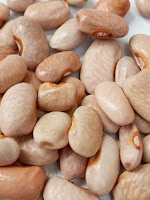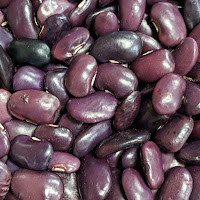Certain combinations of published genes lead to production of a brown pigment when an excess of yellow astragalin would be expected. Here I've made up an enzyme called FNR (FlavoNol Reductase) leading to production of the pigment, modeled after the production of proanthocyanidins by ANR (Anthocyanin Reductase).
The evidence for a brown pigment derived from the yellow pigment pathway comes from the gene B changing a bean color from yellow-brown to mineral/dark-brown when present. B is thought to be a transcription factor that enhances the expression of other pathway genes. Yellow can only arise when red and blue pigment branches are absent, so the brown pigment produced with B can't be the brown proanthocyanidins derived from the red and blue pigment branches. Instead it must be an analogous pigment produced from kaempferol and/or astragalin. I haven't found any research papers discussing this pigment pathway branch, but all the evidence seems to point to it being there anyhow.
The figure trimmed to the metabolites and pigments significant in common beans... now includes pelargonidins. This version of the figure has different thickness arrows in places to illustrate when one branch has a higher priority, when one branch of metabolites is more likely than another.Dihydrokaempferol is a central metabolite for all the different pigment branches in the pathway. F3'H and F3'5'H leading to red and blue pigments have the strongest branches, followed by FLS leading to yellow pigments, and then last is DFR leading to orange pigments. For the orange pigments to dominate the final color, it looks like the other three branches have to be disabled or significantly reduced.
So. Are there orange varieties of common bean? Maybe. Instagram user @g3netic_lottery shared a mixed variety of beans they grew this year and some of them had a distinctly orange-ish color, especially in the hilium ring. Now, I'm not entirely sure that is the color of pelargonidin, but it is the closest to orange I've seen in common beans. It's enough of a suggestion that I decided to rework the pathway figure to include it for this species.I still think it would be really cool to find (or breed up) a variety that had distinctly orange color all over the seed. These beans at right hint that it is feasible if one has the right sort of luck. @g3netic_lottery on Instagram grows beans and other crops in South Africa. I'll be keeping my eye out for useful seeds more accessible to me that might help me get to a nicely orange common bean.
The other domesticated bean species will have very similar pathways as the common bean, but the specific available mutations are going to be different. Maybe we can find a good pelargonidin orange color in one of them. I spent some time looking around for orange seeded varieties of the other species, with limited luck.
- Runner beans (P. coccineus): This photo of "Ayacote Mexican" beans includes some very orange looking seeds, but I have no idea how much that reflects reality.
- Lima beans (P. lunatus): "Pima Orange" has seeds that look yellow-brown or orange depending on the photo. Again, it is hard to say what they really look like.
- Tepary beans (P. acutifolius) : There are some photos around of very orange tepary beans, but I can't find any varieties available for sale that look anything near orange.
- Year-long beans (P. dumosus) : This species is interesting, but only grown in a limited area. I found several articles about it, but I have yet to find anyone selling seeds.
- Some seed sources:
- dualsnatural.com/products/ayocote-mexican-beans : P. coccineus "Ayacote Mexican".
- https://masienda.com/products/ayocote-beans : P. coccineus "Ayacote Pinto".
- www.nativeseeds.org/products/pl011: P. lunatus "Pima Orange"
- www.nativeseeds.org/collections/indigenous-seeds-bean-tepary: P. acutifolius varieties.





No comments:
Post a Comment